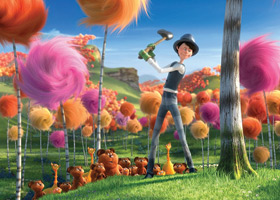Saving the Truffula Trees
 Dr. Seuss’ The Lorax did not sugarcoat its environmental message. Greed and exploitation would ruin the Earth, one Truffula tree at a time. It was a dark message to be sure, but one that’s become more relevant than ever in the face of peak oil, a warming world and rapid habitat and species decline. The animated, 3-D version of The Lorax, in theaters March 2, puts the story in a modern (though still Seuss-like and fanciful) world, where the hero Ted (voiced by Zac Efron) learns just how important individual actions can be. Below, director Chris Renaud, who also directed Despicable Me, talks to E about the film’s importance.
Dr. Seuss’ The Lorax did not sugarcoat its environmental message. Greed and exploitation would ruin the Earth, one Truffula tree at a time. It was a dark message to be sure, but one that’s become more relevant than ever in the face of peak oil, a warming world and rapid habitat and species decline. The animated, 3-D version of The Lorax, in theaters March 2, puts the story in a modern (though still Seuss-like and fanciful) world, where the hero Ted (voiced by Zac Efron) learns just how important individual actions can be. Below, director Chris Renaud, who also directed Despicable Me, talks to E about the film’s importance.
1. E Magazine: Is The Lorax widely known, or will this be an unfamiliar story for many movie-goers?
Chris Renaud: I think that in the U.S. a lot of people have been teaching it in schools and are aware of it. A lot of that environmental awareness is becoming a part of our whole consciousness and our education system and it feels like the book has got some notice mainly because of that in the last few years. As far as Dr. Seuss stories, the awareness of it is certainly below the biggies of The Cat in the Hat and The Grinch. It’s one of the stories that may be off the beaten track, but people who do know it have a real fondness for it.
2. E: How do you think the story’s environmental message will resonate today?
C.R.: Being a kid in the ’60s and ’70s I remember all the concern about logging, and there was a novel—The Monkey Wrench Gang—about environmental activism, and it felt like the story grew out of that to a certain degree. Our approach is that it’s still about trees, but it’s about a bigger picture as well. And even beyond the environment, it’s about taking personal responsibility in trying to make the world a better place. Thinking about your actions and understanding that they have repercussions.
3. E: You obviously had to embellish and add a lot. Especially with Ted and Audrey (Taylor Swift), the main characters.

C.R.: In the book, there’s the boy who comes to hear the tale of the Once-ler. And we make that boy, Ted, the hero of the story. The boy represents the new generation, the one that the Once-ler passes the Truffula seed on to, to try to make the world a better place. Ted’s world—a town called Sneedville—is very much like our world. There are inflatable things on people’s lawns, there are big cars. It’s completely devoid of nature, of anything real. It’s like Vegas or Dubais or Disneyland. Manicured, artificial. What Ted finds is that this world can’t be sustained. He sees it as an island in the middle of a wasteland. And of course that island eventually is going to run out of what it needs.
Audrey is an idealistic young woman who Ted has a crush on. She introduces him to the fact that there used to be trees in this world. For him, it starts as a quest to get something for this girl he has a crush on—a selfish motivation. As he comes to hear the tale, he realizes that it’s about more than this girl, it’s about trying to make the world a better place. I think that’s very true of our own journeys too. You tend to start with a very narrow motivation and then hopefully you can see beyond yourself and your own needs.
4. E: What can you tell me about the role of Norma, the grandmother (Betty White)?
C.R.: She serves the role of being the voice of memory—remembering the world as a better place. Remembering real trees, real nature. As a result, she becomes Ted’s ally, trying to make sure he can sneak out of town. She’s a person who wistfully looks to the past and knows that something magic has been lost and wants to help her grandson recapture it.
5. E: Visually, there’s a lot of fun to be had with Seuss’ style. Were there challenges in making it 3-D?
C.R.: Seuss has a visual style that’s extremely informative for how we approached this design. But at the end of the day, they are 2-D drawings. The Truffula trees in the book are so great and candy-colored, but one of the challenges was making them believable. Our idea of what trees are is very specific. If you have a tree that looks like a lollipop, then you don’t believe it, you don’t feel anything. It’s trying to create something that has this believable texture. We used birch trees for how the trunks would look, and talked about what we could relate to in our world—such as dandelions—for the tops of the trees.
BRITA BELLI is editor of E.

